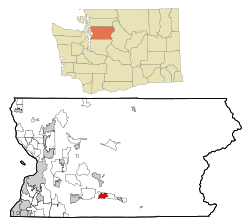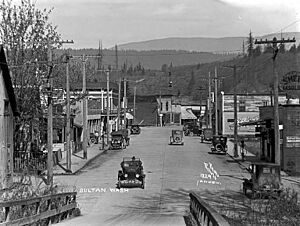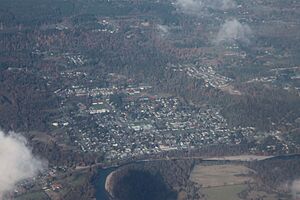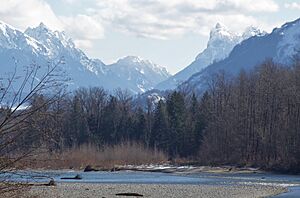Sultan, Washington facts for kids
Quick facts for kids
Sultan, Washington
|
|||
|---|---|---|---|

Main Street in downtown Sultan
|
|||
|
|||

Location of Sultan, Washington
|
|||
| Country | United States | ||
| State | Washington | ||
| County | Snohomish | ||
| Established | 1880 | ||
| Incorporated | June 28, 1905 | ||
| Government | |||
| • Type | Mayor–council | ||
| Area | |||
| • Total | 3.27 sq mi (8.48 km2) | ||
| • Land | 3.27 sq mi (8.48 km2) | ||
| • Water | 0.00 sq mi (0.00 km2) | ||
| Elevation | 108 ft (33 m) | ||
| Population
(2020)
|
|||
| • Total | 5,146 | ||
| • Estimate
(2022)
|
6,205 | ||
| • Density | 1,573.70/sq mi (606.84/km2) | ||
| Time zone | UTC-8 (Pacific (PST)) | ||
| • Summer (DST) | UTC-7 (PDT) | ||
| ZIP code |
98294
|
||
| Area code | 360 | ||
| FIPS code | 53-68260 | ||
| GNIS feature ID | 1526700 | ||
Sultan is a city in Snohomish County, Washington, United States. It is about 23 miles (37 km) east of Everett. Sultan is located where the Skykomish River and the Sultan River meet. In 2020, about 5,146 people lived in Sultan.
The city started in 1880. It was built on the site of a Skykomish Native American village. Early settlers came during a small gold rush. Sultan was officially planned out in 1889. This happened just before the Great Northern Railway arrived. The city became important for mining and the lumber industry. Sultan officially became a city on June 28, 1905. At that time, it had about 700 residents.
Today, Sultan is often called a "bedroom community." This means many people live here but travel to bigger cities for work. The city has several public parks and a historic museum. It is also close to outdoor recreation areas in the Cascade Mountains. U.S. Route 2 connects Sultan to nearby cities.
Contents
History of Sultan
Early Beginnings and Native People
The land around the Sultan and Skykomish rivers was home to the Skykomish people. They were a group related to the Snohomish people. They lived here before American settlers arrived. The Skykomish had a village called tʷ'tsɬitɬd where the rivers met. They also had a fishing spot nearby.
In 1880, gold was found along the Sultan River. John Nailor and his wife claimed land there for a homestead. This was a way to get land from the government. Some of the first people to arrive were Chinese prospectors. They later settled the land but were asked to leave in 1885.
John Nailor built a small shop and a hotel. These served the miners and loggers. He also became the first postmaster when a post office opened in 1885. The town and river were named "Sultan." This name came from Tseul-tud, who was a chief of the Skykomish tribe.
Growth and Development in the Early 1900s
In 1889, the Nailors sold 20 acres (8.1 ha) of their land to William B. Stevens. He created the first official plan for Sultan City in October. The Great Northern Railway set up a supply station in Sultan in 1891. This helped the town grow, as it met river steamboats.
Sultan got its first sawmill in 1891 and a shingle mill in 1895. This meant the local economy changed. It moved from mining to cutting down trees. Sultan officially became a city on June 28, 1905. At that time, it had 700 people and three general stores.
By 1912, Sultan had a public library and electricity. Its streets were paved. The city also thought about building a hydroelectric dam. This dam would make electricity and provide drinking water. A bridge was built across the Skykomish River in 1908. This connected the city to new farms on the south side.
Challenges and Changes Through the Years
After World War I, the economy slowed down. This caused fewer people to live in the Skykomish Valley. In June 1920, Sultan voters agreed to make the city smaller. During the Prohibition era, there were some illegal activities in the area. There were also several serious events, including a sad event where the town marshal, Percy Brewster, lost his life in 1927.
The area also faced hard times during the Great Depression. A Civilian Conservation Corps camp was set up in Sultan. These workers helped with firefighting and forest care. The Works Progress Administration also helped build things in the city. They expanded the high school and its gym in 1929 and 1939.
Several big fires happened in Sultan in the 1940s. One fire in October 1945 destroyed a block of buildings on Main Street. Another fire in 1947 badly damaged the Sultan Union High School.
Modern Improvements and Community Life
In the 1950s and 1960s, Sultan residents worked to improve their city. They upgraded many important buildings and services. A new city hall opened in 1954. The elementary school was made bigger in 1957. A new landing field for planes and helicopters opened in 1958.
The city also added 33 acres (13 ha) of rural land in 1958. This land was then used for new homes. The Skykomish River Bridge was replaced with a new one in 1961. The Snohomish County Public Utility District (PUD) built the Culmback Dam on the Sultan River. This dam created Spada Lake. It has provided electricity and drinking water for Everett and much of the county since 1965.
The Sky River Rock Festival
The Sky River Rock Festival and Lighter Than Air Fair was held near Sultan. It was one of the first outdoor music festivals in the U.S. It started on August 30, 1968, at a raspberry farm. The festival lasted three days. It attracted about 20,000 people.
Many famous music acts performed there. These included Santana, the Grateful Dead, and Muddy Waters. The city of Sultan did not allow the festival to return the next year. This was because of traffic and other problems. The event was mostly forgotten by local people. However, it was brought back for a special festival in 2017.
Sultan Today: A Growing Community
Sultan has grown into a "bedroom community." Many people who live here travel to work in Everett, Seattle, and Bellevue. New housing areas were built in the 1990s and early 2000s. This led to a big increase in population. It also caused some disagreements about keeping the town's small-town feel.
Sultan celebrated its 100th birthday in 2005. There were several festivals and a new visitor's center. Even with more people, some of the city's older businesses have left. This has led to fewer local job options.
To help with growth and money issues, a nearby city suggested merging. But Sultan decided to find other solutions. The city government now gets help from county agencies for policing and library services. Sultan also wants to attract new businesses. It offers land and has opened new parks and a shooting range. This is to appeal to outdoor recreation companies.
Geography and Nature
Sultan is located in south-central Snohomish County. It sits along the Skykomish River. The Sultan and Wallace rivers also join the Skykomish here. Sultan is about 23 miles (37 km) east of Everett, the county seat.
U.S. Route 2 and the BNSF Railway's Scenic Subdivision run through the city. They connect Sultan to Everett, Monroe, Gold Bar, and Stevens Pass. The city's borders are generally the Skykomish River to the south. The Sultan River and Old Owens Road are to the west. Various county roads are to the north and east. The city covers about 3.15 square miles (8.16 km²).
Sultan is in the Skykomish Valley. This valley is surrounded by the foothills of the Cascade mountains. You can see several tall peaks from Sultan. These include Mount Pilchuck, Mount Index, and Mount Persis. The Sultan Basin is a flat area with some rolling hills. It is on the north side of the Skykomish River.
Downtown Sultan is one of three areas in the city that can flood. About 30 percent of residents live in these areas. There have been big floods as recently as 1991 and 2009. The city has three emergency sirens. These warn residents about floods or other dangers.
Economy and Jobs
In 2015, Sultan had about 3,709 people who could work. The unemployment rate was 10.4 percent. This was much higher than the county average of 3.1 percent. Most Sultan residents work in retail (20.9%). Other common jobs are in education and health services (15.3%), manufacturing (11.9%), and construction (7.0%).
Only 8.8 percent of working residents have jobs within Sultan city limits. Most people travel to other areas for work. Many commute to Monroe (11.0%), Seattle (9.7%), Everett (8.2%), Redmond (6.0%), and Bellevue (5.5%). The average trip to work for Sultan residents was about 38.8 minutes. Most people (80%) drove alone. Some (9.4%) shared rides, and a few (3.6%) used public transit.
Sultan businesses offer about 1,010 jobs. Most of these are in services and manufacturing. The biggest employer in the city is the Sultan School District. It provides 254 jobs.
Population and People
| Historical population | |||
|---|---|---|---|
| Census | Pop. | %± | |
| 1910 | 576 | — | |
| 1920 | 687 | 19.3% | |
| 1930 | 830 | 20.8% | |
| 1940 | 961 | 15.8% | |
| 1950 | 814 | −15.3% | |
| 1960 | 821 | 0.9% | |
| 1970 | 1,119 | 36.3% | |
| 1980 | 1,578 | 41.0% | |
| 1990 | 2,236 | 41.7% | |
| 2000 | 3,344 | 49.6% | |
| 2010 | 4,651 | 39.1% | |
| 2020 | 5,146 | 10.6% | |
| 2022 (est.) | 6,205 | 33.4% | |
| U.S. Decennial Census | |||
Sultan is one of the smaller cities in Snohomish County. In the 2020 census, its population was 5,146. The city's population has grown a lot since the late 1960s. It reached over 3,300 by 2000. Between 2000 and 2005, Sultan's population grew by another 20 percent.
The city government has prepared for more growth. For example, they added new connections to the Spada Lake water supply. By 2035, the city and its nearby growth area are expected to have 8,369 people.
Population Details from 2010
In the 2010 U.S. census, there were 4,651 people living in Sultan. There were 1,607 households and 1,142 families. The city had about 1,476.5 people per square mile (570.1 per km²). There were 1,752 homes, with about 556.2 homes per square mile (214.8 per km²).
Most people (86.2%) were White. Other groups included African American (0.2%), Native American (1.0%), Asian (1.6%), and Pacific Islander (0.2%). About 7.1% were from other races, and 3.7% were from two or more races. People of Hispanic or Latino background made up 12.2% of the population.
Of the households, 44.4% had children under 18. About 52.5% were married couples living together. The average household had 2.89 people. The average family had 3.36 people.
The average age in the city was 32.3 years. About 30.7% of residents were under 18. About 7.3% were 65 or older. The city had slightly more males (51.5%) than females (48.5%).
Culture and Fun
Events and Celebrations
Sultan hosts a yearly three-day street fair in July. It is called the "Sultan Shindig." This festival started in 1983 and brings about 20,000 visitors. It has carnival rides, street vendors, live music, and games. There is also a parade and a car show.
The festival also celebrates the history of the Skykomish Valley. It holds logging contests. These include axe throwing, firewood chopping, and speed climbing. There is also wood sculpting. In 2018, a special beer called Shindig Shandy was made for the event. Another festival happens in late September. It celebrates the return of salmon to the Sultan River.
Parks and Recreation
Sultan has four city parks, all near downtown. It also has several sports and fun facilities. The biggest park is Osprey Park, which is 76 acres (31 ha). It is along the Sultan River and is a regular spot for salmon spawning. The park has picnic tables, sports fields, basketball courts, and a dog park.
Traveler's Park on U.S. Route 2 has a large tree slice from a 1,000-year-old Douglas fir tree. A local logging company gave it to the city in 1976. Sultan opened a skate park in 2008. The city is also home to a Boys & Girls Club. It opened in its current spot in 2015, after a fire destroyed the old club five years earlier.
Well-Known People
- Carolyn Eslick, a state lawmaker and former mayor
- John Koster, a former state lawmaker and county council member
- Boeda Strand, a basket weaver and member of the Snohomish tribe
Education in Sultan
Public schools in the Sultan area are run by the Sultan School District. This district also includes nearby Gold Bar and other rural areas. In 2016, the school district had about 1,992 students and 104 teachers. It has one high school, one middle school, and two elementary schools. One of the elementary schools serves Sultan.
The current high school was built in 1951. It replaced an older building that was destroyed by fire. In 2016, voters did not approve a plan to spend $56 million. This money would have upgraded the four schools and built a new office building. The Sky Valley Historical Society has a small local museum in the city's post office building in downtown Sultan.
City Services and Travel
Transportation and Roads

Sultan is connected to nearby towns by U.S. Route 2 (US 2). This highway runs east–west along the Skykomish and Snohomish rivers. It goes from Everett to Eastern Washington through Stevens Pass. The closest cities on the highway are Monroe, 5 miles (8 km) to the west, and Gold Bar to the east.
About 18,000 vehicles use the highway through Sultan each day. This number is higher in summer and during ski season. US 2 is considered one of the most dangerous highways in the state. This is because of many accidents. Sections of US 2 near Sultan were rebuilt to add safety features. These include roundabouts, rumble strips, warning signs, and more police patrols. A plan to make the highway four lanes wide through Sultan was supported by the city in 2023.
The BNSF Railway's Scenic Subdivision also runs along US 2. It connects Everett to Eastern Washington. It also carries Amtrak's Empire Builder train. The highway and railroad cross the Sultan River on truss bridges. A third bridge is planned for people walking and biking.
Public transportation along US 2 is run by Community Transit. There are two routes that go from Everett Station to Snohomish, Monroe, Sultan, and Gold Bar. Sultan also has a small park and ride lot for commuters. A private airfield, Sky Harbor Airport, is near Sultan. It is open to small planes and has one unpaved runway.
Utilities and Services
Electric power for Sultan homes and businesses comes from the Snohomish County Public Utility District (PUD). This is a public utility that serves all of Snohomish County. The PUD runs the Culmback Dam north of Sultan. This dam makes electricity for the area. It also provides 80 percent of Snohomish County's water supply.
The Sultan city government provides water and water treatment to residents. This comes from a separate city-owned reservoir north of Sultan. Wastewater and stormwater are treated at a plant that releases into the Skykomish River. The city government collects trash. Recycling and yard waste collection are handled by Allied Waste.
See also
 In Spanish: Sultan (Washington) para niños
In Spanish: Sultan (Washington) para niños







